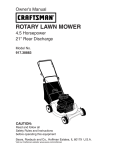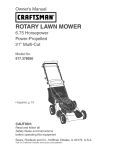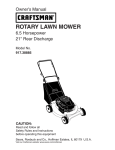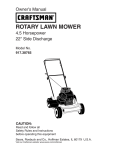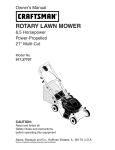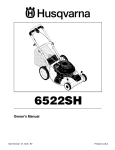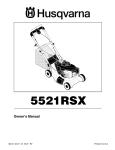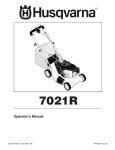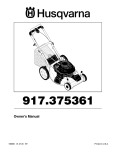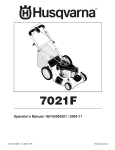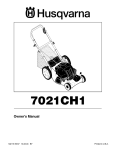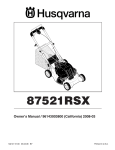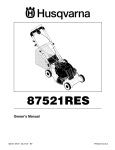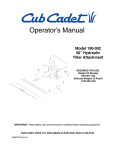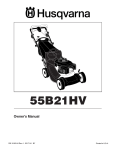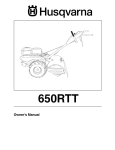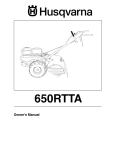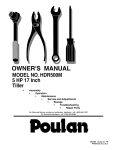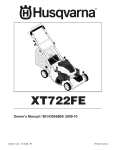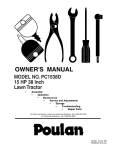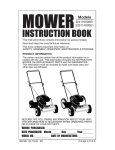Download Husqvarna 917.37595 Lawn Mower User Manual
Transcript
917.375950 Owner’s Manual 196578 Rev. 1 01.27.05 BY Printed in U.S.A. SAFETY RULES Safe Operation Practices for Walk-Behind Mowers IMPORTANT: THIS CUTTING MACHINE IS CAPABLE OF AMPUTATING HANDS AND FEET AND THROWING OBJECTS. FAILURE TO OBSERVE THE FOLLOWING SAFETY INSTRUCTIONS COULD RESULT IN SERIOUS INJURY OR DEATH. • Look for this symbol to point out impor tant safety precautions. It means CAUTION!!! BECOME ALERT!!! YOUR SAFETY IS INVOLVED. • • CAUTION: Always disconnect spark plug wire and place wire where it cannot contact spark plug in order to prevent accidental starting when setting up, transporting, adjusting or making repairs. • • • WARNING: Engine exhaust, some of its constituents, and certain vehicle components contain or emit chemicals known to the State of California to cause cancer and birth defects or other reproductive harm. • • • WARNING: Battery posts, terminals and related accessories contain lead and lead compounds, chemicals known to the State of California to cause cancer and birth defects or other reproductive harm. Wash hands after handling. II. SLOPE OPERATION Slopes are a major factor related to slip and fall accidents which can result in severe injury. All slopes require extra caution. If you feel uneasy on a slope, do not mow it. DO: • Mow across the face of slopes: never up and down. Exercise extreme caution when changing direction on slopes. • Remove obstacles such as rocks, tree limbs, etc. • Watch for holes, ruts, or bumps. Tall grass can hide obstacles. DO NOT: • Do not trim near drop-offs, ditches or embankments. The operator could lose footing or balance. • Do not trim excessively steep slopes. • Do not mow on wet grass. Reduced footing could cause slipping. CAUTION: Muffler and other engine parts become extremely hot during operation and remain hot after engine has stopped. To avoid severe burns on contact, stay away from these areas. I. GENERAL OPERATION • • • • • • • • • • Read, understand, and follow all instructions on the machine and in the manual(s) before starting. Be thoroughly familiar with the controls and the proper use of the machine before starting. Do not put hands or feet near or under rotating parts. Keep clear of the discharge opening at all times. Only allow responsible individuals, who are familiar with the instructions, to operate the machine. Clear the area of objects such as rocks, toys, wire, bones, sticks, etc., which could be picked up and thrown by the blade. Be sure the area is clear of other people before mowing. Stop machine if anyone enters the area. Do not operate the mower when barefoot or wearing open sandals. Always wear substantial foot wear. Do not pull mower backwards unless absolutely necessary. Always look down and behind before and while moving backwards. Never direct discharged material toward anyone. Avoid discharging material against a wall or obstruction. Material may richochet back toward the operator. Stop the blade when crossing gravel surfaces. Do not operate the mower without proper guards, plates, grass catcher or other safety protective devices in place. See manufacturer’s instructions for proper operation and installation of accessories. Only use accessories approved by the manufacturer. Stop the blade(s) when crossing gravel drives, walks, or roads. Stop the engine (motor) whenever you leave the equipment, before cleaning the mower or unclogging the chute. Shut the engine (motor) off and wait until the blade comes to complete stop before removing grass catcher. Mow only in daylight or good artificial light. Do not operate the machine while under the influence of alcohol or drugs. Never operate machine in wet grass. Always be sure of your footing: keep a firm hold on the handle and walk; never run. Disengage the self-propelled mechanism or drive clutch on mowers so equipped before starting the engine (motor). If the equipment should start to vibrate abnormally, stop the engine (motor) and check immediately for the cause. Vibration is generally a warning of trouble. Always wear safety goggles or safety glasses with side shields when operating mower. III. CHILDREN Tragic accidents can occur if the operator is not alert to the presence of children. Children are often attracted to the machine and the mowing activity. Never assume that children will remain where you last saw them. • Keep children out of the trimming area and under the watchful care of another responsible adult. • Be alert and turn machine off if children enter the area. • Before and while walking backwards, look behind and down for small children. • Never allow children to operate the machine. • Use extra care when approaching blind corners, shrubs, trees, or other objects that may obscure vision. IV. SAFE HANDLING OF GASOLINE 2 Use extreme care in handling gasoline. Gasoline is extremely flammable and the vapors are explosive. • Extinguish all cigarettes, cigars, pipes and other sources of ignition. • Use only an approved container. • Never remove gas cap or add fuel with the engine running. Allow engine to cool before refueling. • • • • • • • Never refuel the machine indoors. Never store the machine or fuel container where there is an open flame, spark or pilot light such as a water heater or on other appliances. Never fill containers inside a vehicle, on a truck or trailer bed with a plastic liner. Always place containers on the ground away from your vehicle before filling. Remove gas-powered equipment from the truck or trailer and refuel it on the ground. If this is not possible, then refuel such equipment with a portable container, rather than from a gasoline dispenser nozzle. Keep the nozzle in contact with the rim of the fuel tank or container opening at all times until fueling is complete. Do not use a nozzle lock-open device. If fuel is spilled on clothing, change clothing immediately. Never overfill fuel tank. Replace gas cap and tighten securely. • • • • • • • V. GENERAL SERVICE • • • Never run a machine inside a closed area. Never make adjustments or repairs with the engine (motor) running. Disconnect spark plug wire, and keep • wire away from plug to prevent accidental starting. Keep nuts and bolts, especially blade attachement bolts, tight and keep equipment in good condition. Never tamper with safety devices. Check their proper operation regularly. Keep machine free of grass, leaves, or other debris build-up. Clean oil or fuel spillage. Allow machine to cool before storing. Stop and inspect the equipment if you strike an object. Repair, if necessary, before restarting. Never attempt to make wheel height adjustments while the engine (motor) is running. Grass catcher components are subject to wear, damage, and deterioration, which could expose moving parts or allow objects to be thrown. Frequently check components and replace with manufacturer’s recommended parts, when necessary. Mower blade is sharp and can cut. Wrap the blade or wear gloves, and use extra caution when servicing it. Do not change the engine governor setting or overspeed the engine. Maintain or replace safety and instruction labels, as necessary. WARNING: This lawn mower is equipped with an internal combustion engine and should not be used on or near any unimproved forest-covered, brush-covered or grass-covered land unless the engine’s exhaust system is equipped with a spark arrester meeting applicable local or state laws (if any). If a spark arrester is used, it should be maintained in effective working order by the operator. In the state of California the above is required by law (Section 4442 of the California Public Resources Code). Other states may have similar laws. Federal laws apply on federal lands. A spark arrester for the muffler is available through your nearest Sears Parts & Repair center. CONGRATULATIONS on your purchase of a new lawn mower. It has been designed, engineered and manufactured to give you the best possible dependability and performance. Should you experience any problem you cannot easily remedy, please contact your nearest authorized service center/department. We have competent, well-trained technicians and the proper tools to service or repair this lawn mower. Please read and retain this manual. The instructions will enable you to assemble and maintain your lawn mower properly. Always observe the “SAFETY RULES”. PRODUCT SPECIFICATIONS Gasoline Capacity and Type: 1.6 Quarts (Unleaded Regular Only) Oil Type (API SG–SL): SAE 30 (above 0°C / 32°F) SAE 5W-30 (below 0°C / 32°F) Oil Capacity: 20 Ounces Spark Plug: RJ19LM or J19LM (Gap: .030") Blade Bolt Torque: 35-40 ft. lbs. SERIAL NUMBER: _________________________________ DATE OF PURCHASE: _______________________ THE MODEL AND SERIAL NUMBERS WILL BE FOUND ON A DECAL ATTACHED TO THE REAR OF THE LAWN MOWER HOUSING. CUSTOMER RESPONSIBILITIES • • YOU SHOULD RECORD BOTH SERIAL NUMBER AND DATE OF PURCHASE AND KEEP IN A SAFE PLACE FOR FUTURE REFERENCE. • Read and observe the safety rules. Follow a regular schedule in maintaining, caring for and using your lawn mower. Follow the instructions under “Maintenance” and “Storage” sections of this owner’s manual. TABLE OF CONTENTS SAFETY RULES ......................................................... 2-3 PRODUCT SPECIFICATIONS ....................................... 3 CUSTOMER RESPONSIBILITIES................................. 3 ASSEMBLY ................................................................. 4-5 OPERATION ............................................................. 6-10 MAINTENANCE SCHEDULE ...................................... 11 3 MAINTENANCE ...................................................... 11-13 SERVICE AND ADJUSTMENTS ............................ 14-15 STORAGE ............................................................... 15-16 TROUBLESHOOTING ................................................. 17 REPAIR PARTS....................................................... 18-23 WARRANTY................................................................. 24 ASSEMBLY Read these instructions and this manual in its entirety before you attempt to assemble or operate your new lawn mower. IMPORTANT: THIS LAWN MOWER IS SHIPPED WITHOUT OIL OR GASOLINE IN THE ENGINE. Your new lawn mower has been assembled at the factory with the exception of those parts left unassembled for shipping purposes. All parts such as nuts, washers, bolts, etc., necessary to complete the assembly have been placed in the parts bag. To ensure safe and proper operation of your lawn mower, all parts and hardware you assemble must be tightened securely. Use the correct tools as necessary to ensure proper tightness. OPERATOR PRESENCE CONTROL BAR MOWING POSITION LIFT UP LIFT UP UPPER HANDLE TO REMOVE LAWN MOWER FROM CARTON 1. Remove loose parts included with mower. 2. Cut down two end corners of car ton and lay end panel down flat. 3. Remove all packing materials except padding between upper and lower handle and padding holding operator presence control bar to upper handle. 4. Roll lawn mower out of carton and check carton thorougly for additional loose parts. HANDLE KNOB LOWER HANDLE HOW TO SET UP YOUR LAWN MOWER TO UNFOLD HANDLE (See Figs. 1 and 2) IMPORTANT: UNFOLD HANDLE CAREFULLY SO AS NOT TO PINCH OR DAMAGE CONTROL CABLES. 1. Raise lower handle to operating position and align hole in handle with one of the height positioning holes in the handle bracket. 2. Insert handle bolt through handle and bracket and secure with knob. 3. Repeat for opposite side of handle. 4. Remove protective padding, raise upper handle section into place on lower handle and tighten both handle knobs. 5. Remove packing material from around control bar. Your handles may be adjusted for your mowing comfort. Refer to “ADJUST HANDLE” in the Service and Adjustments section of this manual. FIG. 1 BOLT KNOB HANDLE BRACKET FIG. 2 4 ASSEMBLY TO INSTALL ATTACHMENTS TO ASSEMBLE GRASS CATCHER (See Figs. 3 and 4) Your lawn mower was shipped ready to be used as a mulcher. To convert mower to bagging or discharging, see “TO CONVERT MOWER” in the Operation section of this manual. 1. Slide grass catcher bag over the frame. Make sure the rear handle is on top (the same side as the front handle) and the strap is on the bottom. 2. Slip vinyl bindings over frame. NOTE: If vinyl bindings are too stiff, hold them in warm water for a few minutes. If bag gets wet, let it dry before using. 3. Close grass catcher door. NOTE: When fully closed, door will “snap” shut over frame and vinyl bindings. TO PREPARE BATTERY (See Fig. 5) NOTE: Your battery must be charged before you can start your lawn mower. 1. Connect battery charger connector (male) to harness connector (female). 2. Plug battery charger into 110 volt A.C. outlet. 3. Leave battery charger connected for 24 hours before starting your engine for the first time. 4. After charging, disconnect harness connector (female) from battery charger connector (male). Connect your battery charger to charge battery after each use. IMPORTANT: The engine will not recharge your battery. At the end of the mowing season the battery should be charged for 48 hours to protect the battery during winter storage. REAR HANDLE STRAP CAUTION: Always disconnect the en gine connector (male) from the battery connector (female) to prevent accidental starting when transporting or storing your lawn mower after the season. FRONT HANDLE BATTERY CHARGER BATTERY BOX CHARGER CONNECTOR (MALE) DOOR HARNESS CONNECTOR (FEMALE) FIG. 3 DOOR GRASS CATCHER FRAME ENGINE CONNECTOR (MALE) FIG. 5 VINYL BINDINGS BAG FIG. 4 5 OPERATION KNOW YOUR LAWN MOWER READ THIS OWNER'S MANUAL AND SAFETY RULES BEFORE OPERATING YOUR LAWN MOWER. Compare the illustrations with your lawn mower to familiarize yourself with the location of various controls and adjustments. Save this manual for future reference. These symbols may appear on your mower or in literature supplied with it. Learn and understand their meaning. OPERATOR PRESENCE CONTROL BAR AUXILIARY STARTER HANDLE DRIVE CONTROL LEVER KEY START SWITCH DRIVE COVER HANDLE KNOB ENGINE OIL CAP WITH DIPSTICK PRIMER GRASS CATCHER MUFFLER DUAL POINT HEIGHT ADJUSTER LEVER GASOLINE FILLER CAP MULCHER DOOR AIR FILTER SPARK PLUG IMPORTANT: This lawn mower is shipped WITHOUT OIL OR GASOLINE in the engine. HOUSING MEETS CPSC SAFETY REQUIREMENTS Our rotary walk-behind power lawn mowers conform to the safety standards of the American National Standards Institute and the U.S. Consumer Product Safety Commission. The blade turns when the engine is running. OPERATOR PRESENCE CONTROL BAR – must be held down to the handle to start engine. Release to stop engine. MULCHER DOOR – allows conversion to discharge or bagging operation. PRIMER – pumps additional fuel from the carburetor to the cylinder for use when starting a cold engine. 6 AUXILIARY STARTER HANDLE – used for starting engine. DRIVE CONTROL LEVER – used to engage power-propelled forward motion lawn mower. DUAL POINT HEIGHT ADJUSTER – used to adjust cutting height of lawn mower. KEY START SWITCH – used for starting the engine. OPERATION The operation of any lawn mower can result in foreign objects thrown into the eyes, which can result in severe eye damage. Always wear safety glasses or eye shields while operating your lawn mower or performing any adjustments or repairs. We recommend standard safety glasses or a wide vision safety mask over spectacles. HOW TO USE YOUR LAWN MOWER 2. Turn nut on underside of drive control to increase drive speed. 3. Operate mower to test drive speed. Readjust as required. 4. If condition fails to improve after the above steps (forward speed remains the same), your drive belt is worn and should be replaced. ENGINE SPEED The engine speed was set at the factory for optimum performance. Speed is not adjustable. ENGINE ZONE CONTROL TO ADJUST CUTTING HEIGHT (See Fig. 7) CAUTION: Federal regulations require an engine control to be installed on this lawn mower in order to minimize the risk of blade contact injury. Do not under any circumstances attempt to defeat the function of the operator control. The blade turns when the engine is running. • Both front wheels are adjusted by a single lever on the left front wheel. Likewise, both rear wheels are adjusted by a single lever on the left rear wheel. • Pull adjuster lever toward wheel. To raise mower, move lever forward to desired position. To lower mower, move the lever toward the rear. Be sure to adjust both front and rear wheels to same height. Your lawn mower is equipped with an operator presence control bar which requires the operator to be positioned behind the lawn mower handle to start and operate the lawn mower. HEIGHT ADJUSTER LEVER LEVER BACKWARD TO LOWER MOWER DRIVE CONTROL (See Fig. 6) • Self-propelling is controlled by holding the operator presence control bar down to the handle and pulling the drive control lever rearward to the handle. The farther toward the handle the lever is pulled, the faster the unit will travel. • Forward motion will stop when either the operator presence control bar or drive control lever are released. To stop forward motion without stopping engine, release the drive control lever only. Hold operator presence control bar down against handle to continue mowing without self-propelling. NOTE: If after releasing the drive control the mower will not roll backwards, push the mower forward slightly to disengage drive wheels. LEVER FORWARD TO RAISE MOWER FIG. 7 TO CONVERT MOWER (See Figs. 8 thru 10) Your lawn mower was shipped ready to be used as a mulcher. To convert to rear bagging or side discharging: OPERATOR PRESENCE CONTROL BAR REAR BAGGING • Remove knob securing mulcher door to mower housing. • Open mulcher door and insert tabs of discharge chute into hinge bracket opening and position rear of chute over threaded stud. DRIVE CONTROL LEVER ADJUSTMENT TURNBUCKLE (ON UNDERSIDE) TO ENGAGE DRIVE CONTROL DISCHARGE CHUTE TABS DRIVE CONTROL DISENGAGED FIG. 6 DRIVE CONTROL ADJUSTMENT (See Fig. 6) Over time, the drive control system may become “loose”, resulting in decreased speed. There is a turnbuckle on the underside of the drive control housing to increase tension on the drive cable. Proceed as follows: 1. Turn unit off and disconnect spark plug wire from plug. HINGE BRACKET 7 FIG. 8 MULCHER DOOR OPERATION • Secure rear of discharge chute to lawn mower housing with knob. • Place rear handle of grass catcher on the crossbar of the lawn mower's lower handle as shown. • Lift the round door of the discharge chute and place the grass catcher into place on the discharge chute. NOTE: Be sure round door of discharge chute rests on grass catcher as shown. • Mower is now ready for rear bagging operation. • To convert to mulching operation, remove grass catcher and discharge chute. Secure mulcher door to mower housing with knob. • To convert to side discharging operation, remove grass catcher and discharge chute. Install side discharge deflector and secure it to mower housing with knob. • • • Mower is now ready for side discharging operation. To convert to mulching operation, side discharge deflector must be removed and mulcher door secured to mower housing with knob. To convert to rear bagging operation, side discharge deflector must be removed; discharge chute and grass catcher installed and discharge chute secured to mower housing with knob. MULCHER DOOR KNOB THREADED STUD REAR HANDLE CROSSBAR GRASS CATCHER SIDE DISCHARGE DEFLECTOR FIG. 10 ROUND DOOR SIMPLE STEPS TO REMEMBER WHEN CONVERTING YOUR LAWN MOWER FOR MULCHING 1. Grass catcher, discharge chute and side discharge deflector removed. 2. Mulcher door secured to mower housing with knob. KNOB DISCHARGE CHUTE THREADED STUD FOR REAR BAGGING 1. Side discharge deflector removed. 2. Grass catcher and discharge chute installed with discharge chute secured to lawn mower housing with knob. 3. Round door of discharge chute resting on top of grass catcher. MULCHER DOOR FOR SIDE DISCHARGING 1. Grass catcher and discharge chute removed. 2. Side discharge deflector installed and secured to mower housing with knob. FIG. 9 SIDE DISCHARGING • Grass catcher and discharge chute must be removed. • Open mulcher door and install front of side discharge deflector beneath it as shown. • Secure rear of side discharge deflector to lawn mower housing with knob. CAUTION: Do not run your lawn mower without mulcher door closed; side discharge deflector installed, or discharge chute and approved grass catcher in place. Never attempt to operate the lawn mower with mulcher door or round door removed or propped open. 8 OPERATION TO EMPTY GRASS CATCHER (See Figs. 11 –12) BEFORE STARTING ENGINE 1. Open round door of discharge chute to move starter rope out and away from grass catcher. ADD OIL (See Fig. 13) Your lawnmower is shipped without oil in the engine. For type and grade of oil to use, see “ENGINE” in the Maintenance section of this manual. FRONT HANDLE OPEN CAUTION: DO NOT overfill engine with oil, or it will smoke heavily from the muffler on startup. ROUND DOOR 1. Be sure lawnmower is level. 2. Remove oil dipstick from oil fill spout. 3. You receive a container of oil with the unit. Slowly pour the entire container down the oil fill spout into the engine. NOTE: Initial oil fill requires only 18 oz. due to residual oil in engine from the manufacturers 100% quality testing. When changing oil you may need 20 oz. 4. Insert and tighten dipstick. IMPORTANT: • Check oil level before each use. Add oil if needed. Fill to full line on dipstick. • Change the oil after every 25 hours of operation or each season. You may need to change the oil more often under dusty, dirty conditions. See “TO CHANGE ENGINE OIL” in the Maintenance section of this manual. STARTER ROPE FIG. 11 2. Remove grass catcher with clippings from lawn mower using both front and rear handles. 3. Empty clippings from bag using rear handle and strap. The weight of the grass will open the door. 4. Snap door shut over frame before installing grass catcher on mower. NOTE: Do not drag the bag when emptying; it will cause unnecessary wear. GASOLINE FILLER CAP ENGINE OIL CAP REAR HANDLE STRAP PRIMER FRONT HANDLE FIG. 13 DOOR FIG. 12 9 OPERATION • ADD GASOLINE (See Fig. 13) • Fill fuel tank to bottom of tank filler neck. Do not overfill. Use fresh, clean, regular unleaded gasoline with a minimum of 87 octane. Do not mix oil with gasoline. Purchase fuel in quantities that can be used within 30 days to assure fuel freshness. • CAUTION: Wipe off any spilled oil or fuel. Do not store, spill or use gasoline near an open flame. Alcohol blended fuels (called gasohol or using ethanol or methanol) can attract moisture which leads to separation and formation of acids during storage. Acidic gas can damage the fuel system of an engine while in storage. To avoid engine problems, the fuel system should be emptied before storage of 30 days or longer. Empty the gas tank, start the engine and let it run until the fuel lines and carburetor are empty. Use fresh fuel next season. See Storage Instructions for additional information. Never use engine or carburetor cleaner products in the fuel tank or permanent damage may occur. • • • MULCHING MOWING TIPS IMPORTANT: FOR BEST PERFORMANCE, KEEP MOWER HOUSING FREE OF BUILT-UP GRASS /TRASH.SEE“CLEANING” IN THE MAINTENANCE SECTION OF THIS MANUAL. • TO STOP ENGINE • Under certain conditions, such as very tall grass, it may be necessary to raise the height of cut to reduce pushing effort and to keep from overloading the engine and leaving clumps of grass clippings. It may also be necessary to reduce ground speed and/or run the lawn mower over the area a second time. For extremely heavy cutting, reduce the width of cut by overlapping previously cut path and mow slowly. For better grass bagging and most cutting conditions, the engine speed should be set in the fast position. Pores in cloth grass catchers can become filled with dirt and dust with use and catchers will collect less grass. To prevent this, regularly hose catcher off with water and let dry before using. Keep top of engine around starter clear and clean of grass clippings and chaff. This will help engine air flow and extend engine life. To stop engine, release operator presence control bar. • TO START ENGINE NOTE: Due to protective coatings on the engine, a small amount of smoke may be present during the initial use of the product and should be considered normal. 1. To start a cold engine, push primer three (3) times before trying to start. Use a firm push. This step is not usually necessary when starting an engine which has already run for a few minutes. 2. Hold operator presence control bar down to the handle and turn the start key. IMPORTANT: Do not crank engine more than five continous seconds between each time you try to start. Wait 5 to 10 seconds between each attempt. • To start engine using the rope starter, follow the steps above. Exchange the use of the starter rope for start key. Pull starter handle quickly. Do not allow starter rope to snap back. NOTE: In cooler weather it may be necessary to repeat priming steps. In warmer weather over priming may cause flooding and engine will not start. If you do flood engine, wait a few minutes before attempting to start and do not repeat priming steps. • The special mulching blade will recut the grass clippings many times and reduce them in size so that as they fall onto the lawn they will disperse into the grass and not be noticed. Also, the mulched grass will biodegrade quickly to provide nutrients for the lawn. Always mulch with your highest engine (blade) speed as this will provide the best recutting action of the blades. Avoid cutting your lawn when it is wet. Wet grass tends to form clumps and interferes with the mulching action. The best time to mow your lawn is the early afternoon. At this time the grass has dried, yet the newly cut area will not be exposed to direct sunlight. For best results, adjust the lawn mower cutting height so that the lawn mower cuts off only the top one-third of the grass blades (See Fig. 14). If the lawn is overgrown it will be necessary to raise the height of cut to reduce pushing effort and to keep from overloading the engine and leaving clumps of mulched grass. For extremely heavy mulching, reduce your width of cut by overlapping previously cut path and mow slowly. MAX 1/3 FIG. 14 MOWING TIPS • CAUTION: Do not use de-thatcher blade attachments on your mower. Such attachments are hazardous, will damage yourmowerandcouldvoidyourwarranty. • 10 Certain types of grass and grass conditions may require that an area be mulched a second time to completely hide the clippings. When doing a second cut, mow across (perpendicular) to the first cut path. Change your cutting pattern from week to week. Mow north to south one week then change to east to west the next week. This will help prevent matting and graining of the lawn. MAINTENANCE BEFORE EACH USE AFTER EACH USE EVERY 10 HOURS EVERY 25 HOURS OR SEASON EVERY 100 HOURS BEFORE STORAGE Check for Loose Fasteners Clean / Inspect Grass Catcher * Check Tires Check Drive Wheels *** Clean Lawn Mower **** Clean under Drive Cover *** Check Drive Belt / Pulleys *** Check / Sharpen / Replace Blade Lubrication Clean and Recharge Battery ** Check Engine Oil level Change Engine Oil Clean Air Filter Inspect Muffler Replace Spark Plug Replace Air Filter Paper Cartridge Empty fuel system or add Stabilizer * (if so equipped) ** Electric-Start mowers *** Power-Propelled mowers a scraper **** Use to clean under deck 1 - Change more often if operating under a heavy load or in high outdoor temperatures. 2 - Service more often if operating in dirty or dusty conditions. 3 - Replace blades more often when mowing in sandy soil. 4 - Charge 48 hours at end of season. 5 - And after each 5 hours of use. GENERAL RECOMMENDATIONS LUBRICATION CHART The warranty on this lawn mower does not cover items that have been subjected to operator abuse or negligence. To receive full value from the warranty, operator must maintain mower as instructed in this manual. Some adjustments will need to be made periodically to properly maintain your unit. At least once a season, check to see if you should make any of the adjustments described in the Service and Adjustments section of this manual. • At least once a year, replace the spark plug, clean or replace air filter element and check blade for wear. A new spark plug and clean/new air filter element assure proper air-fuel mixture and help your engine run better and last longer. • Follow the maintenance schedule in this manual. BEFORE EACH USE ➁ ENGINE OIL ➀ MULCHER DOOR HINGE PIN ➀ REAR DOOR HINGE 1. Check engine oil level. 2. Check for loose fasteners. LUBRICATION Keep unit well lubricated (See “LUBRICATION CHART”). IMPORTANT: DO NOT OIL OR GREASE PLASTIC WHEEL BEARINGS. VISCOUS LUBRICANTS WILL ATTRACT DUST AND DIRT THAT WILL SHORTEN THE LIFE OF THE SELFLUBRICATING BEARINGS. IF YOU FEEL THEY MUST BE LUBRICATED, USE ONLY A DRY, POWDERED GRAPHITE TYPE LUBRICANT SPARINGLY. ➀ HANDLE BRACKET MOUNTING PINS ➀ SPRAY LUBRICANT ➁ SEE “ENGINE” IN MAINTENANCE SECTION 11 MAINTENANCE LAWN MOWER BLADE Always observe safety rules when performing any maintenance. BLADE ADAPTER TRAILING EDGE TIRES • • Keep tires free of gasoline, oil, or insect control chemicals which can harm rubber. Avoid stumps, stones, deep ruts, sharp objects and other hazards that may cause tire damage. HARDENED WASHER DRIVE WHEELS Check rear drive wheels each time before you mow to be sure they move freely. The wheels not turning freely means trash, grass cuttings, etc. are in the drive wheel area and must be cleaned to free drive wheels. If necessary to clean the drive wheels, be sure to clean both rear wheels. LOCK WASHER BLADE BOLT FIG. 15 TO SHARPEN BLADE NOTE: We do not recommend sharpening blade - but if you do, be sure the blade is balanced. Care should be taken to keep the blade balanced. An unbalanced blade will cause eventual damage to lawn mower or engine. • The blade can be sharpened with a file or on a grinding wheel. Do not attempt to sharpen while on the mower. • To check blade balance, drive a nail into a beam or wall. Leave about one inch of the straight nail exposed. Place center hole of blade over the head of the nail. If blade is balanced, it should remain in a horizontal position. If either end of the blade moves downward, sharpen the heavy end until the blade is balanced. BLADE CARE For best results, mower blade must be kept sharp. Replace bent or damaged blades. CAUTION: Use only a replacement blade approved by the manufacturer of your mower. Using a blade not approved by the manufacturer of your mower is hazardous, could damage your mower and void your warranty. TO REMOVE BLADE (See Fig. 15) 1. Disconnect spark plug wire from spark plug and place wire where it cannot come in contact with plug. 2. Turn lawn mower on its side. Make sure air filter and carburetor are up. 3. Use a wood block between blade and mower housing to prevent blade from turning when removing blade bolt. NOTE: Protect your hands with gloves and/or wrap blade with heavy cloth. 4. Remove blade bolt by turning counter-clockwise. 5. Remove blade and attaching hardware (bolt, lock washer and hardened washer). GRASS CATCHER • The grass catcher may be hosed with water, but must be dry when used. Check your grass catcher often for damage or deterioration. Through normal use it will wear. If catcher needs replacing, replace only with approved replacement catcher shown in the Repair Parts section of this manual. Give the lawn mower model number when ordering. • ENGINE LUBRICATION Use only high quality detergent oil rated with API service classification SG–SL. Select the oil's SAE viscosity grade according to your expected operating temperature. TO REPLACE BLADE (See Fig. 15) 1. Position blade on the blade adapter aligning the two (2) holes in the blade with the raised lugs on the adapter. 2. Be sure the trailing edge of blade (opposite sharp edge) is up toward the engine. 3. Install the blade bolt with the lock washer and hardened washer into blade adapter and crankshaft. 4. Use block of wood between blade and lawn mower housing and tighten the blade bolt, turning clockwise. • The recommended tightening torque is 35-40 ft. lbs. SAE VISCOSITY GRADES SAE 30 5W-30 -20 F C -30 0 -20 30 -10 32 0 40 60 10 100 80 20 30 40 TEMPERATURE RANGE ANTICIPATED BEFORE NEXT OIL CHANGE il i h 1 NOTE: Multi-viscosity oils (5W30, 10W30 etc.) improve starting in cold weather, and you should check your engine oil level frequently to avoid possible engine damage from running low on oil. IMPORTANT: BLADE BOLT IS HEAT TREATED. IF BOLT NEEDS REPLACING, REPLACE ONLY WITH APPROVED BOLT SHOWN IN THE REPAIR PARTS SECTION OF THIS MANUAL. 12 MAINTENANCE Change the oil after every 25 hours of operation or at least once a year if the lawn mower is not used for 25 hours in one year. Check the crankcase oil level before starting the engine and after each five (5) hours of continuous use. Tighten oil plug securely each time you check the oil level. CAUTION: Petroleum solvents, such as kerosene, are not to be used to clean cartridge.They may cause deterioration of the cartridge. Do not oil cartridge. Do not use pressurized air to clean or dry cartridge. TO CHANGE ENGINE OIL (See Fig. 16) 4. Install cartridge, then replace cover making sure the tabs are aligned with the slots in the back plate. Fasten screw securely. NOTE: Before tipping lawn mower to drain oil, empty fuel tank by running engine until fuel tank is empty. 1. Disconnect spark plug wire from spark plug and place wire where it cannot come in contact with plug. 2. Remove engine oil cap; lay aside on a clean surface. 3. Tip lawn mower on its side as shown and drain oil into a suitable container. Rock lawn mower back and forth to remove any oil trapped inside of engine. BACK PLATE SLOTS LIP CARTRIDGE COVER COVER TABS FIG. 17 MUFFLER Inspect and replace corroded muffler as it could create a fire hazard and/or damage. CONTAINER 4. 5. 6. 7. 8. 9. SPARK PLUG Replace spark plug at the beginning of each mowing season or after every 100 hours of operation, whichever occurs first. Spark plug type and gap setting are shown in the “PRODUCT SPECIFICATIONS” section of this manual. FIG. 16 Wipe off any spilled oil from lawn mower or side of engine. Slowly pour oil down the oil fill spout, stopping every few ounces to check the oil level with the dipstick. Stop adding oil when you reach the FULL mark on the dipstick. Wait a minute to allow oil to settle. Continue adding small amounts of oil, rechecking the dipstick until oil level settles at FULL. DO NOT overfill, or engine will smoke heavily from the muffler on startup. Always be sure to retighten oil dipstick before starting engine. Reconnect spark plug wire to spark plug. CLEANING IMPORTANT: FOR BEST PERFORMANCE, KEEP MOWER HOUSING FREE OF BUILT-UP GRASS AND TRASH. CLEAN THE UNDERSIDE OF YOUR MOWER AFTER EACH USE. CAUTION: Disconnect spark plug wire from spark plug and place wire where it cannot come in contact with plug. • AIR FILTER (See Fig. 17) • Your engine will not run properly and may be damaged by using a dirty air filter. Replace the air filter cartridge every 100 hours of operation or every season, whichever occurs first. Service air cleaner more often under dusty conditions. • • TO CLEAN AIR FILTER 1. Loosen screw and tilt cover to remove. 2. Carefully remove cartridge. 3. Clean by gently tapping on a flat surface. If very dirty, replace car tridge. Clean the underside of your lawn mower by scraping to remove build-up of grass and trash. Clean engine often to keep trash from accumulating. A clogged engine runs hotter and shortens engine life. Keep finished surfaces and wheels free of all gasoline, oil, etc. We do not recommend using a garden hose to clean lawn mower unless the electrical system, muffler, air filter and carburetor are covered to keep water out. Water in engine can result in shortened engine life. CLEAN UNDER DRIVE COVER 13 Clean under drive cover at least twice a season. Scrape underside of cover with putty knife or similar tool to remove any build-up of trash or grass on underside of drive cover. SERVICE AND ADJUSTMENTS CAUTION: TO AVOID SERIOUS INJURY, BEFORE PERFORMING ANY SERVICE OR ADJUSTMENTS: 1. Release control bar and stop engine. 2. Make sure the blade and all moving parts have completely stopped. 3. Disconnect spark plug wire from spark plug and place wire where it cannot come in contact with plug. 4. Pivot idler arm assembly to slacken drive belt, then remove drive belt from drive pulley, belt keepers and idler arm. 5. Turn lawn mower on its side. Make sure air filter and carburetor are up. 6. Remove screw securing debris shield. Note that the debris shield has a tab which fits into a gap in the housing (See Fig. 20). LAWN MOWER TO ADJUST CUTTING HEIGHT See “TO ADJUST CUTTING HEIGHT” in the Operation section of this manual. REAR DEFLECTOR The rear deflector, attached between the rear wheels of your mower, is provided to minimize the possibility that objects will be thrown out of the rear of the mower into the operator's mowing position. If the deflector becomes damaged, it should be replaced. HOUSING HOLE CRANKSHAFT TAB BLADE ADAPTER TO REMOVE DRIVE BELT (See Figs. 18–20) 1. Disconnect spark plug wire from spark plug and place wire where it cannot come in contact with plug. 2. Remove screws retaining drive cover and remove drive cover from lawn mower housing (See Fig. 18). HARDENED WASHER DEBRIS SHIELD SCREWS LOCKWASHER SCREW BLADE BOLT TRAILING EDGE FIG. 20 7. Use a wood block between blade and mower housing to prevent blade from turning when removing blade bolt. NOTE: Protect your hands with gloves and/or wrap blade with heavy cloth. 8. Remove blade bolt. 9. Remove blade, attaching hardware (bolt, lock washer, hardened washer), blade adapter and debris shield as one assembly. 10. Remove drive belt from blade adapter and debris shield; discard old belt. LAWN MOWER HOUSING DRIVE COVER FIG. 18 3. Remove drive cable from anchor, then detach it and return spring from idler arm assembly (See Fig. 19). TO REPLACE DRIVE BELT (See Figs. 18–21) 1. Place new drive belt in the belt retainer of the debris shield. Be sure to route belt between belt keepers and through slot as shown (See Fig. 21). DRIVE CABLE ANCHOR RETURN SPRING DEBRIS SHIELD DRIVE BELT TAB BELT KEEPERS DRIVE BELT HOUSING HOLE DRIVE PULLEY PIVOT BELT KEEPER FIG. 19 IDLER ARM ASSEMBLY SLOT 14 FIG. 21 BELT RETAINER SERVICE AND ADJUSTMENTS 2. Route the other end of the new drive belt through hole in housing. 3. Reattach debris shield to housing with screw previously removed. Be sure tab of debris shield is in gap of housing. 4. Position blade on the blade adapter aligning the two (2) holes in the blade with the raised lugs on the adapter. 5. Be sure the trailing edge of blade (opposite sharp edge) is up toward the engine as shown (See Fig. 20). 6. Install the blade bolt with the lock washer and hardened washer into blade adapter and crankshaft. 7. Use block of wood between blade and lawn mower housing and tighten the blade bolt, turning clockwise. • The recommended tightening torque is 35-40 ft. lbs. KNOB BOLT LOW HANDLE BRACKET HIGH IMPORTANT: BLADE BOLT IS HEAT TREATED. IF BOLT NEEDS REPLACING, REPLACE ONLY WITH APPROVED BOLT SHOWN IN THE REPAIR PARTS SECTION OF THIS MANUAL. FIG. 22 8. Return mower to upright position. 9. Install new drive belt into idler arm assembly, then around the drive pulley. Be sure belt is inside of belt keepers (See Fig. 19). NOTE: Pulling on the drive belt (to install it on the drive pulley) will cause the other end of the belt to free itself from the debris shield retainer and come into contact with the pulley end of the blade adapter. 10. Reattach drive cable and return spring to the idler arm assembly, then reattach drive cable to anchor. 11. Reattach drive cover with screws previously removed (See Fig. 18). ENGINE ENGINE SPEED Your engine speed has been factory set. Do not attempt to increase engine speed or it may result in personal injury. If you believe that the engine is running too fast or too slow, take your lawn mower to a Sears or other authorized service center for repair and adjustment. CARBURETOR Your carburetor is not adjustable. If your engine does not operate properly due to suspected carburetor problems, take your lawn mower to a Sears or other authorized service center for repair and/or adjustment. 12. Connect spark plug wire to spark plug. IMPORTANT: NEVERTAMPER WITHTHE ENGINE GOVERNOR, WHICH IS FACTORY SET FOR PROPER ENGINE SPEED. OVERSPEEDING THE ENGINE ABOVE THE FACTORY HIGH SPEED SETTING CAN BE DANGEROUS. IF YOU THINK THE ENGINE-GOVERNED HIGH SPEED NEEDS ADJUSTING, CONTACT YOUR NEAREST SEARS OR OTHER AUTHORIZED SERVICE CENTER, WHICH HAS PROPER EQUIPMENT AND EXPERIENCE TO MAKE ANY NECESSARY ADJUSTMENTS. TO ADJUST HANDLE (See Fig. 22) The handle on your lawn mower has multiple height positions - adjust to height that suits you. 1. Remove knob and carriage bolt on one side of the lower handle. 2. While holding handle assembly, remove knob and carriage bolt from opposite side, align hole in handle with desired hole in handle bracket and reassemble bolt and knob and tighten securely. 3. Align opposite side of handle with same positioning hole and secure with bolt and knob. STORAGE Immediately prepare your lawn mower for storage at the end of the season or if the unit will not be used for 30 days or more. LAWN MOWER When lawn mower is to be stored for a period of time, clean it thoroughly, remove all dirt, grease, leaves, etc. Store in a clean, dry area. 1. Clean entire lawn mower (See “CLEANING” in the Maintenance section of this manual). 2. Lubricate as shown in the Maintenance section of this manual. 3. Be sure that all nuts, bolts, screws, and pins are securely fastened. Inspect moving parts for damage, breakage and wear. Replace if necessary. 4. Touch up all rusted or chipped paint surfaces; sand lightly before painting. 15 STORAGE HANDLE (See Figs. 23 and 24) ENGINE You can fold your lawn mower handle for storage. 1. Loosen the two (2) handle knobs on sides of the upper handle and allow handle to fold down to the rear. 2. Remove the two (2) handle knobs and carriage bolts on sides of the lower handle and pivot entire handle assembly forward and allow it to rest on mower. 3. Reinstall knobs and carriage bolts to lower handle or handle brackets for safe keeping. • When setting up your handle from the storage position, you must manually lock the lower handle into the mowing position. FUEL SYSTEM IMPORTANT: IT IS IMPORTANT TO PREVENT GUM DEPOSITS FROM FORMING IN ESSENTIAL FUEL SYSTEM PARTS SUCH AS CARBURETOR, FUEL FILTER, FUEL HOSE, OR TANK DURING STORAGE. ALCOHOL BLENDED FUELS (CALLED GASOHOL OR USING ETHANOL OR METHANOL) CAN ATTRACT MOISTURE WHICH LEADS TO SEPARATION AND FORMATION OF ACIDS DURING STORAGE. ACIDIC GAS CAN DAMAGE THE FUEL SYSTEM OF AN ENGINE WHILE IN STORAGE. • Empty the fuel tank by starting the engine and letting it run until the fuel lines and carburetor are empty. • Never use engine or carburetor cleaner products in the fuel tank or permanent damage may occur. • Use fresh fuel next season. NOTE: Fuel stabilizer is an acceptable alternative in minimizing the formation of fuel gum deposits during storage. Add stabilizer to gasoline in fuel tank or storage container. Always follow the mix ratio found on stabilizer container. Run engine at least 10 minutes after adding stabilizer to allow the stabilizer to reach the carburetor. Do not empty the gas tank and carburetor if using fuel stabilizer. IMPORTANT: WHEN FOLDING THE HANDLE FOR STORAGE OR TRANSPORTATION, BE SURE TO FOLD THE HANDLE AS SHOWN OR YOU MAY DAMAGE THE CONTROL CABLES. MOWING POSITION OPERATOR PRESENCE CONTROL BAR FOLD FORWARD FOR STORAGE ENGINE OIL Drain oil (with engine warm) and replace with clean engine oil. (See “ENGINE” in the Maintenance section of this manual). UPPER HANDLE CYLINDER HANDLE KNOB 1. Remove spark plug. 2. Pour one ounce (29 ml) of oil through spark plug hole into cylinder. 3. Pull starter handle slowly a few times to distribute oil. 4. Replace with new spark plug. LOWER HANDLE BATTERY Disconnect the battery from the engine connector and charge battery 48 hours. OTHER FIG. 23 • • KNOB • BOLT • HANDLE BRACKET Do not store gasoline from one season to another. Replace your gasoline can if your can starts to rust. Rust and/or dirt in your gasoline will cause problems. If possible, store your unit indoors and cover it to give protection from dust and dirt. Cover your unit with a suitable protective cover that does not retain moisture. Do not use plastic. Plastic cannot breathe, which allows condensation to form and will cause your unit to rust. IMPORTANT: NEVER COVER MOWER WHILE ENGINE AND EXHAUST AREAS ARE STILL WARM. CAUTION: Never store the lawn mower with gasoline in the tank inside a building where fumes may reach an open flame or spark. Allow the engine to cool before storing in any enclosure. FIG. 24 16 TROUBLESHOOTING POINTS PROBLEM Does not start CAUSE 1. Dirty air filter. 2. Out of fuel. 3. Stale fuel. 4. 5. 6. 7. 8. 9. 10. 11. 12. Loss of power CORRECTION 1. Clean/replace air filter. 2. Fill fuel tank. 3. Empty fuel tank and refill tank with fresh, clean gasoline. Water in fuel. 4. Empty fuel tank and refill tank with fresh, clean gasoline. Spark plug wire is disconnected. 5. Connect wire to plug. Bad spark plug. 6. Replace spark plug. Loose blade or broken blade adapter. 7. Tighten blade bolt or replace blade adapter. Control bar in released position. 8. Depress control bar to handle. Control bar defective. 9. Replace control bar. Fuel valve lever (if equipped) in OFF position. 10. Turn fuel valve lever to the ON position. Weak battery (if equipped). 11. Charge battery. Disconnected battery connector (if equipped). 12. Connect battery to engine. 1. Rear of lawn mower housing or cutting blade dragging in heavy grass. 2. Cutting too much grass. 3. Dirty air filter. 4. Buildup of grass, leaves and trash under mower. 5. Too much oil in engine. 6. Walking speed too fast. 1. Raise cutting height. 2. Raise cutting height. 3. Clean/replace air filter. 4. Clean underside of mower housing. 5. Check oil level. 6. Cut at slower walking speed. Poor cut – uneven 1. Worn, bent or loose blade. 2. Wheel heights uneven. 3. Buildup of grass, leaves and trash under mower. 1. Replace blade. Tighten blade bolt. 2. Set all wheels at same height. 3. Clean underside of mower housing. Excessive vibration 1. Worn, bent or loose blade. 2. Bent engine crankshaft. 1. Replace blade. Tighten blade bolt. 2. Contact a Sears Parts & Repair center. Starter rope hard to pull 1. Engine flywheel brake is on when control bar is released. 2. Bent engine crankshaft. 3. Blade adapter broken. 4. Blade dragging in grass. 1. Depress control bar to upper handle before pulling starter rope. 2. Contact a Sears Parts & Repair center. 3. Replace blade adapter. 4. Move lawn mower to cut grass or other hard surface before starting. Grass catcher not filling (if so equipped) 1. Cutting height too low. 2. Lift on blade worn off. 3. Catcher not venting air. 1. Raise cutting height. 2. Replace blade. 3. Clean grass catcher. Hard to push 1. Grass is too high or wheel height is too low. 2. Rear of lawn mower housing or cutting blade dragging in heavy grass. 3. Grass catcher too full. 4. Handle height position not right for you. 1. Raise cutting height. 2. Raise rear of lawn mower housing one (1) setting higher. 3. Empty grass catcher. 4. Adjust handle height to suit. Loss of drive (or slowing of drive speed) 1. 2. 3. 4. 1. 2. 3. 4. Belt wear. Belt off of pulley. Drive cable worn or broken. “Loose” drive control system. 17 Check/replace drive belt. Check/reinstall drive belt. Put belt on pulleys / replace belts if broken. Adjust drive control. ROTARY LAWN MOWER - - MODEL NUMBER 917.375950 18 ROTARY LAWN MOWER - - MODEL NUMBER 917.375950 19 KEY NO. PART NO. DESCRIPTION 1 2 3 4 5 6 7 8 9 10 11 12 13 14 15 16 17 18 19 20 21 22 23 24 25 26 27 28 29 30 31 32 33 34 35 190582 65322 183483 194736 188506 12000014 190581 183479 72140405 73800400 190692 196474 190519 184572 150406 189028 851074 850263 191760 186766 190516 17600406 183609 751152 183445 183446 107339 190515 183447 190580 183478 183445 190578 190619 185588 Handle, Grassbag, Rear Hairpin Cotter Rod, Rear Handle, Grassbag Grassbag Frame, Grassbag ERing Door, Grassbag Rod, Pivot Bolt Nut, Hex Tube, Rear Skirt Skirt, Rear Cover, Front Screw, Hex Washer Head Bolt, Engine Mounting Blade, 21" Washer, Hardened Washer, Lock Bolt, Hex Head, Grade 8 Adapter, Blade Debris Shield Screw, Hex Head, Serrated Mounting Bracket, Mulcher Door Nut, Hex Rod, Hinge Spring, Mulcher Door Decal, Danger Mulcher Door Knob Door, Discharge Chute Spring, Door, Discharge Chute Rod, Door, Discharge Chute Discharge Chute, Plastic Adjustment Bracket, Lower Handle, LH Knob, Star KEY NO. PART NO. 36 37 38 39 40 42 43 44 45 46 47 48 49 50 51 52 183465 185996 190621 191574 66426 187096 186298 182748 186296 164322 750634 125203 132004 188501 189792 --- 53 194735 54 189014 55 56 57 73 74 75 76 77 78 79 80 --- 188628 12000058 188634 196355 196942 17411312 186159 180331 132004 194134 190097 162300 196578 DESCRIPTION Bolt, Shoulder Deflector, Discharge Adjustment Bracket, Lower Handle, RH Bolt, Handle Wire Tie Handle Assembly, Lower Bail, Control Grip, Foam Handle Assembly, Upper (Includes Foam Grip) Cable, Engine Zone Control Screw Bracket, Upstop Nut, Hex 1/4-20 Rope Guide Kit, Housing Engine, Briggs & Stratton, Model No. 125K05-0499-E1 (For engine service and replacement parts, call Briggs & Stratton at 1-800-233-3723) Grassbag Assembly, Complete (Consists of Key Numbers 18) Discharge Chute Assembly, Complete (Consists of Key Numbers 30 through 33) Stud, Shoulder, T45 ERing, T45 Stud, Threaded 1/420 x 5/8 Battery Box, Battery Screw, Hex Washer Head #13 x 3/4 Screw, Hex Head 1/4-20 x 2-11/64 Key Nut, Hex, Flangelock 1/4-20 Control, Electric Start (Includes Key) Charger, Battery Decal, Warning (not shown) Owner's Manual NOTE: All component dimensions given in U.S. inches. 1 inch = 25.4 mm. IMPORTANT: Use only Original Equipment Manufacturer (O.E.M.) replacement parts. Failure to do so could be hazardous, damage your lawn mower and void your warranty. ROTARY LAWN MOWER - - MODEL NUMBER 917.375950 20 ROTARY LAWN MOWER - - MODEL NUMBER 917.375950 21 KEY NO. PART NO. 1 197012 2 3 4 5 6 7 8 9 10 11 12 13 14 15 16 17 18 19 21 22 23 24 25 26 27 28 195761 187353 190037 195762 181698 187097 186297 197011 196956 184571 12000012 183450 187120 188294 194124 196822 163409 194128 132004 193791 188152 145212 73930500 196542 166043 160829 DESCRIPTION KEY NO. PART NO. DESCRIPTION Drive Control Assembly, Complete (Consists of Key Numbers 2 through 7) Cover, Drive Control, Top Pulley, Drive Control Lever, Drive Control (blue) Cover, Drive Control, Bottom Screw, Torx Head #8-5/8 Bracket, Mounting, Drive Control Cap, Drive Control, Bottom Cable, Drive Control Cover Assembly, Drive Screw Ring, Retaining Screw Bearing / Axle Support Gear Case Assembly (See Breakdown) Spring, Return Bracket, Gear Case / Drive Pulley Screw Pulley, Drive Nut, Hex Pulley Assembly, VGroove ORing Nut, Hex, Flangelock Nut, Hex, Lock Idler Arm Pulley, Idler Bolt, Hex Head, Shoulder 29 30 31 32 33 34 35 36 37 38 39 40 41 42 43 44 45 46 47 48 49 50 51 52 53 54 55 69 17060410 183457 88348 192619 83923 183695 185994 188291 175098 12000058 175103 175105 175104 184172 190520 190518 163409 192230 183438 169675 196469 183688 188331 175102 195995 188330 189074 751068 Screw 1/4-20 x 1-1/16 Cover, Dust, Wheel Washer, Flat 3/8 Wheel Assembly, Rear 9 x 2-1/4 Nut, Hex Hubcap Knob Spring, Torsion Pawl ERing Gear Retainer, Drive, LH Disc, Drive Seal, Friction Lever, Selector, Wheel Height, Rear Lever, Selector, Wheel Height, Front Screw Wheel Assembly, Front 9 x 2-1/4 Bushing, Front Axle Retainer, Hairpin Cotter Torque Shaft Assembly, Front Belt, Drive Pinion Assembly, LH Retainer, Drive, RH Rear Axle Assembly Pinion Assembly, RH Decal, Drive Control Bearing, Ball (Wheel) NOTE: All component dimensions given in U.S. inches. 1 inch = 25.4 mm. IMPORTANT: Use only Original Equipment Manufacturer (O.E.M.) replacement parts. Failure to do so could be hazardous, damage your lawn mower and void your warranty. ROTARY LAWN MOWER - - MODEL NUMBER 917.375950 GEAR CASE ASSEMBLY - - PART NUMBER 188294 KEY NO. 1 2 3 4 5 6 7 8 9 10 11 12 -- PART NO. 187530 191245 187532 191246 183505 183506 183508 183509 183511 191247 183513 183514 750369 DESCRIPTION Case, Lower Case, Upper Gear, 24 Teeth Shaft, Worm Wireform Bearing, Ball Seal, Output Shaft Washer Bushing Shaft, Output Screw Seal, Worm Shaft Grease, Texaco Starplex Premium 1 (Do not substitute) (1.4 ounce capacity) NOTE: All component dimensions given in U.S. inches. 1 inch = 25.4 mm. IMPORTANT: Use only Original Equipment Manufacturer (O.E.M.) replacement parts. Failure to do so could be hazardous, damage your lawn mower and void your warranty. 22 SERVICE NOTES 23 LIMITED TWO YEAR WARRANTY ON POWER MOWER For two years from date of purchase, when this Lawn Mower is maintained, lubricated, and tuned up according to the operating and maintenance instructions in the owner’s manual, Sears will repair free of charge any defect in material or workmanship. If this Lawn Mower is used for commercial or rental purposes, this warranty applies for only 90 days from the date of purchase. This Warranty does not cover: • Expendable items which become worn during normal use, such as rotary mower blades, blade adapters, belts, air cleaners and spark plug. • Repairs necessary because of operator abuse or negligence, including bent crankshafts and the failure to maintain the equipment according to the instructions contained in the owner’s manual. Warranty service is available by returning the Lawn Mower to the nearest Sears Parts & Repair Center in the United States. This warranty applies only while this product is used in the United States. This Warranty gives you specific legal rights, and you may also have other rights which vary from state to state. Sears, Roebuck And Co., D/817 WA, Hoffman Estates, Il 60179 24
























